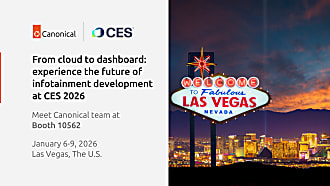Bertrand Boisseau
on 7 February 2024
Driving towards Environmental Parity and Software-Defined Vehicles with EB corbos Linux – built on Ubuntu
Authors:
Dr. Joachim Schlosser, Senior Manager, Elektrobit
Bertrand Boisseau, Automotive Sector Lead at Canonical
The intersection of SDVs and HPCs
As the automotive industry continues to advance into the world of high-performance computing (HPC), it becomes increasingly crucial to achieve environmental parity for seamless software integration. In this blog post, we will explore the synergy between Elektrobit and Canonical at the core of ‘EB corbos Linux – built on Ubuntu‘ in the context of automotive computing. This partnership not only takes advantage of cutting-edge technology but also emphasises a commitment to open-source principles.

EB corbos Linux – built on Ubuntu, serves as a flexible and unique platform designed to meet the evolving needs of the automotive industry, particularly in the context of technologies like advanced driver assistance (ADAS) and electric vehicles (EV). This solution is aimed at providing a secure and reliable environment for connected vehicles, making it suitable for Tier 1s (suppliers) and OEMs (original equipment manufacturers) that are transitioning towards software-defined vehicles (SDVs). Let’s dig into the intricacies of HPC in automotive and explore how EB corbos Linux – built on Ubuntu, can play a vital role in reshaping the automotive software development landscape.
Navigating towards SDVs involves a profound connection between the vehicle electrical and electronic (E/E) architecture, HPC and, in general, the arrival of in-vehicle servers. When focusing on complex computing functions and containerised services, the next phase in E/E architecture will rely on centralised zonal controllers revolving around a central server, which would act as a key component often referred to as the “vehicle server” or the “vehicle HPC”. While its power will be notably less than that of cloud-based HPC, it will differ from a technical standpoint. This vehicle server will benefit from the abstraction layers defined by domain focused E/E architectures and will rely on cloud-native approaches.
Environmental parity in the SDV era
Recently, we’ve highlighted the significance of environmental parity in accelerating automotive software development. We emphasised the challenges posed by hardware-related issues in the software-driven innovation of the automotive sector. Environmental parity serves as a solution to replicate the properties of physical vehicle components in a cloud environment, ensuring software performance under real-world vehicle conditions. By encouraging a modular, cloud-native approach, environmental parity reduces hardware constraints and enables cross-platform software development within the context of software-defined vehicles.
Achieving environmental parity involves replicating real-world conditions, including real-time capabilities, sensor inputs, hardware capabilities, and communication protocols. Cloud-based development platforms can facilitate this process, allowing automotive Linux systems to meet the requirements of the runtime hardware environment in automotive applications and transfer the adherence to these requirements to the cloud environment.
“AWS offers value to its automotive customers through an extensive portfolio of purpose-built industry solutions, services, and partner offerings. With Elektrobit and Canonical launching the Elektrobit corbos Linux (EBcL) based on Ubuntu with support for AWS Graviton via AWS Marketplace, AWS customers can access EBcL instantly and start developing automotive applications on ARM architecture-compatible Graviton EC2 instances,” said Stefano Marzani, worldwide tech leader for Software Defined Vehicle at AWS. “This offering is another testament to the power of collaborative software development in the cloud. Integrating added value stacks from Elektrobit into Canonical’s offering enables automakers using AWS to accelerate their SDV roadmap and “shift-left” automotive development, validation and testing. Automakers can start developing automotive applications on Amazon EC2 instances powered by Arm-based AWS Graviton2 processors, and EBcL”
Cloud execution with embedded architecture in mind

In the field of software development, the traditional approach of relying on physical prototypes presents several challenges. One of these challenges is the limited availability of Production and R&D electronic control units (ECUs), which often leads to delays in design and development processes. Another challenge is the cost and complexity of deploying and collaborating on Hardware in Loop (HiL) systems across multiple time zones. In order to stay competitive, OEMs (Original Equipment Manufacturers) must embrace a cultural shift towards a faster, more focused, and agile engineering approach. By leveraging an “always-on” cloud infrastructure, globally distributed teams can collaborate seamlessly, enabling agile development and faster delivery of customer value. Elektrobit and long-term Canonical partner AWS have joined forces to accelerate SDV implementations by adopting a cloud-first workflow, as part of the “Shift Left” approach.
Concretely, AWS Graviton is a family of ARM-based processors developed by Amazon Web Services (AWS) for their cloud computing infrastructure. These processors offer customers a cost-effective alternative for running workloads in the cloud. By using an ARM architecture, known for its energy efficiency and widespread use in mobile devices, Graviton processors provide enhanced performance and efficiency characteristics. These processors are responsible for powering a wide range of AWS instances known as Graviton instances, such as the Amazon EC2 A1 instances. Graviton instances are specifically designed to handle various workloads, including web servers, containerised applications, and microservices. By using AWS Graviton, users have the flexibility to choose instances based on their specific application requirements, optimising costs and resource use.
EB corbos Linux – built on Ubuntu, which is dedicated to the automotive industry, has made significant advancement by running on AWS Graviton processors. This integration enables organisations to take advantage of the efficiency of Graviton’s ARM-based architecture while maintaining the reliability of EB corbos Linux – built on Ubuntu. Developers who are familiar with EB corbos Linux – built on Ubuntu can fully leverage the capabilities of AWS Graviton without sacrificing performance. This collaboration provides a streamlined solution where embedded systems can integrate with the scalability and resource optimisation benefits of AWS Graviton. It enables the use of virtual ECUs running Linux and AUTOSAR classic systems on the cloud, opening up new possibilities for automotive software development.

Enhancing automotive software development: the power of containerisation
In the realm of automotive software development, the efficient management and isolation of software components are pivotal for ensuring reliability and consistency.
Containerisation is a method of packaging software into lightweight, standalone elements called containers. These encapsulate all the necessary dependencies and libraries required for the software to run, providing a consistent and reliable environment across different platforms and systems. By using containers, automotive developers can easily deploy and scale their applications, while ensuring that each component is isolated and therefore, does not interfere with others. This allows for more efficient testing, and maintenance of automotive systems.
Software isolation is crucial in the complex landscape of automotive software to prevent interference between different components. This is achieved through virtualisation or containerisation, which acts as a protective barrier. Containerisation is a central feature of EB Corbos Linux – built on Ubuntu.
Containerisation Technologies
EB containers
Elektrobit’s specialised approach, known as EB containers, enforces stringent resource boundaries and abstracts the base OS release for midlife upgrades. EB containers also provide tamper-proof security with verified on-disk formats and encrypted storage. Compliance with the Open Container Initiative (OCI) standards enables migration to cloud and edge environments.
EB has developed an OCI-compliant container deployment and runtime solution specifically for embedded systems. This solution integrates with backends, can support multiple instances, and facilitates cloud migration.
Snaps
Offering a comprehensive and efficient approach to software deployment, Snaps are encapsulated packages that contain both the application and its dependencies. While not yet offered via EB Corbos Linux – Built on Ubuntu, this unique packaging format guarantees a consistent and reliable experience across various Linux distributions, eliminating compatibility issues that can arise in the diverse ecosystem of automotive software development. Snaps provide unparalleled convenience thanks to automatic updates and rollbacks, enhancing the security and stability of the software. Canonical has been dedicated to the Snap ecosystem and simplifies application adaptation to evolving requirements.
Docker
Docker is an example of a containerisation technology that helped push software encapsulation. By bundling software and its dependencies within containers, developers can easily replicate the same software stack across various environments, ensuring consistency and can help to reach environmental parity. The adoption of containerisation, such as the implementation of EB containers or Snaps, provides automotive software developers with a powerful tool. This strategic approach enhances the overall development process by strengthening component isolation, streamlining deployment and runtime management, while facilitating integration with cloud environments.
We’ve seen how encapsulation can help to isolate software components. The next step is to ensure that software assembly and deployment is consistent, ensuring reliability and traceability.
Reproducible builds
Configuration management plays a key role in streamlining the development of automotive software. By using tools such as Ansible or Puppet, organisations can ensure consistency in configuration settings across various stages of development, testing, and production. This uniformity guarantees that the software behaves reliably, regardless of the stage in the development lifecycle.
In the domain of automation, Continuous Integration and Continuous Deployment (CI/CD) pipelines play a significant role. These pipelines serve as a crucial component in automating the process of testing, validating, and deploying automotive software. They ensure that the same codebase undergoes rigorous testing and is consistently deployed across different environments. This leads to improved efficiency, reduced errors, and ultimately, a higher quality end-product.
For customised image generation, based for example on EB corbos Linux – built on Ubuntu, a robust toolchain is essential. This involves managing image configuration through a comprehensive configuration management system. To ensure a seamless workflow from development to deployment, it is important to have a complete development solution that includes cloud-enabled and containerised tools. Additionally, leveraging Open Build Service (OBS) for build and delivery management adds an extra layer of efficiency. OBS ensures that the development and delivery process is smooth and well-organised, allowing for effective collaboration among team members.

Environmental parity as a path towards SDVs
Elektrobit and Canonical’s strong common commitment to open-source is integral to both companies’ offerings. By actively engaging in the communities of these projects, Elektrobit and Canonical ensure a collaborative and evolving approach to software development. This approach benefits developers by providing them with immediate access to all essential components, allowing for a quick start to application development. This open-source foundation not only demonstrates Elektrobit’s and Canonical’s commitment to industry-standard practices but also empowers developers with accessible and versatile tools for streamlined application development and deployment.
The process of creating fully functional test environments that accurately replicate the constraints and behaviours of vehicle hardware involves a combination of different simulation techniques. These techniques are crucial in ensuring that the virtual hardware and software integration step moves from an initial prototype stage to a widely used production component. By implementing such simulation techniques, organisations can test and validate the performance of their vehicle systems implementation in a controlled and realistic environment before the actual implementation. Doing so minimises the risks and costs associated with physical testing and allows for more efficient development and optimisation of vehicle hardware and software. As a result, the use of simulation techniques in the automotive industry continues to evolve and to play a key role in improving the overall product quality and performance.
In the rapidly evolving landscape of automotive high-performance computing, EB corbos Linux – built on Ubuntu showcases the power of open-source innovation. This partnership between Elektrobit and Canonical not only demonstrates the potential for environmental parity, but also sets a new standard in the automotive industry. By leveraging these technologies, software development becomes more efficient, streamlined, and reliable. Thanks to EB corbos Linux – built on Ubuntu, we can imagine a future where innovation integrates with practicality, transforming the way we view automotive computing.

Further reading
Learn about EB corbos Linux – built on Ubuntu!
How to choose an OS for software development in automotive
Implementing FOTA updates for vehicles using a Dedicated Snap Store
Want to learn more about emerging automotive technologies? Read our whitepaper on 2024 trends.



